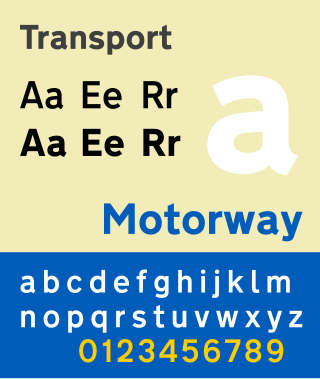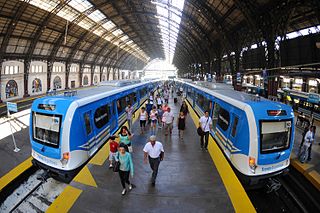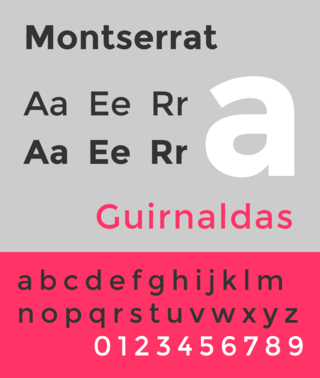
Transport in Argentina is mainly based on a complex network of routes, crossed by relatively inexpensive long-distance buses and by cargo trucks. The country also has a number of national and international airports. The importance of the long-distance train is minor today, though in the past it was widely used and is now regaining momentum after the re-nationalisation of the country's commuter and freight networks. Fluvial transport is mostly used for cargo.

The Buenos Aires Underground, locally known as Subte, is a rapid transit system that serves the area of the city of Buenos Aires, Argentina. The first section of this network opened in 1913, making it the 13th subway in the world and the first underground railway in Latin America, the Southern Hemisphere, and the Spanish-speaking world, with the Madrid Metro opening five years later, in 1919. As of 2023, Buenos Aires is the only Argentine city with a metro system.

Rail Alphabet is a neo-grotesque sans-serif typeface designed by Jock Kinneir and Margaret Calvert for signage on the British Rail network. First used at Liverpool Street station, it was then adopted by the Design Research Unit (DRU) as part of their comprehensive 1965 rebranding of the company.
Margaret Vivienne Calvert is a British typographer and graphic designer who, with colleague Jock Kinneir, designed many of the road signs used throughout the United Kingdom, Crown Dependencies, and British Overseas Territories, as well as the Transport font used on road signs, the Rail Alphabet font used on the British railway system, and an early version of the signs used in airports. The typeface developed by Kinneir and Calvert was further developed into New Transport and used for the single domain GOV.UK website in the United Kingdom.

Transport is a sans serif typeface first designed for road signs in the United Kingdom. It was created between 1957 and 1963 by Jock Kinneir and Margaret Calvert as part of their work as designers for the Department of Transport's Anderson and Worboys committees.
Herbert Spencer was a British designer, editor, writer, photographer and teacher. He was born in London.

The Tranvía del Este, also known as the Puerto Madero Tramway, was a 12-block "demonstration" light rail line in the Puerto Madero neighborhood of Buenos Aires, Argentina, in operation from 2007 to 2012. It used French-built Alstom Citadis 302 trams on loan, initially from Mulhouse, France, and later from Madrid, Spain, and was operated by the rail company Ferrovías.

The Traffic Signs Regulations and General Directions is the law that sets out the design and conditions of use of official traffic signs that can be lawfully placed on or near roads in Great Britain and the Isle of Man. The regulations, originally introduced in 1965, were the result of the review of British road signage carried out by the Worboys Committee.

The Mitre line is an Argentine broad gauge commuter rail service in Buenos Aires Province and is part of the Ferrocarril General Bartolomé Mitre division. The service is currently operated by the State-owned company Operadora Ferroviaria Sociedad del Estado after the Government of Argentina rescinded its contract with Corredores Ferroviarios in March 2015.

The San Martín line is a 70-kilometre (43 mi), 22-station commuter rail service in the metropolitan area of Buenos Aires, Argentina. The San Martín line operates from the city-centre terminus of Retiro north-west to Doctor Cabred in Luján Partido along a broad gauge line built by the British-owned Buenos Aires and Pacific Railway.
Richard "Jock" Kinneir was a British typographer and graphic designer who, with his colleague Margaret Calvert, designed many of the road signs used throughout the United Kingdom, Crown Dependencies, and British overseas territories. Their system has become a model for modern road signage.

Motorway is a sans-serif typeface designed by Jock Kinneir and Margaret Calvert for use on the motorway network of the United Kingdom. Motorway was first used on the M6 Preston bypass in 1958 and has been in use on the UK's motorways ever since. The typeface is also used in some other countries, most notably Ireland and Portugal.

The Design Research Unit (DRU) was one of the first generation of British design consultancies combining expertise in architecture, graphics and industrial design. It was founded by the managing director of Stuart Advertising Agency, Marcus Brumwell with Misha Black and Milner Gray in 1943. It became well known for its work in relation to the Festival of Britain in 1951 and its influential corporate identity project for British Rail in 1965. In 2004, DRU merged with Scott Brownrigg architects.

National Route 1, also known as Buenos Aires–La Plata Highway and officially called Autopista Doctor Ricardo Balbín since 2004, is a highway that connects the 25 de Mayo Highway and Paseo del Bajo in the city of Buenos Aires with the Provincial Route 11, near the city of La Plata. It has a length of 50 km (31 mi) with two or four lanes on each direction in different areas, and is indicated in red in the map.

Ronald Shakespear is an Argentine graphic designer, mostly known for the Buenos Aires Visual Plan, designed along Guillermo González Ruiz in 1971–72. and other visual identity systems for several companies.

Autovía 2 Juan Manuel Fangio is an Argentine dual carriageway, which runs from Buenos Aires to Mar del Plata. The road was a National Route until 1990 when it was transferred to the Government of Buenos Aires Province. The Autovía 2 extends from the junction of Provincial Routes 1 and 36 and National Route A004, just on the traffic circle "Juan María Gutiérrez", which is the limit of Berazategui and Florencio Varela districts.
In Argentina, road signs are similar to those of other South American countries. They are something of a compromise between the Vienna Convention signs used in Europe and the U.S. system. Argentina is right-hand traffic.

Montserrat is a geometric sans-serif typeface designed by Argentine graphic designer Julieta Ulanovsky and released in 2011. It was inspired by posters, signs and painted windows from the first half of the twentieth century, seen in the historic Montserrat neighbourhood of Buenos Aires.

The Faculty of Architecture, Design and Urbanism is a faculty of the University of Buenos Aires (UBA), the largest university in Argentina. Established in 1901 as the School of Architecture, it has since expanded to impart courses on graphic design and urbanism.



















